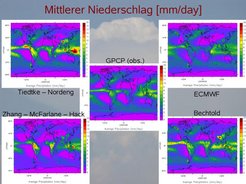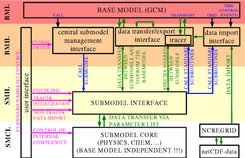New Software for Modelling Earth Systems
2005 Billing Prize for scientific computation goes to the Max Planck Institute for Chemistry's "Modular Earth Submodel System (MESSy)"
For the development of a modular structured software environment, the "Modular Earth Submodel System (MESSy)", Patrick Jöckel and Rolf Sander of the Max Planck Institute for Chemistry in Mainz, Germany have been awarded the 2005 Heinz Billing Prize, including a 3000 euro endowment. In order to provide efficient, flexible computer simulations of the close spatiotemporal interaction of air chemical and meteorological processes, various program modules around the world have to be linked closely together. MESSy integrates into one software environment a large number of models describing physical and chemical atmospheric processes. It also analyses how these processes react to one another. This is a major step toward a single Earth system model of how processes in the ocean, on land, and in the air interact. Also among the top three prize winners were Evgeny Gavrilov and Michael Joswig of the Department of Mathematics at the Technical University in Darmstadt for their paper "Geometric Reasoning with polymake", a program with a range of functions for polytopes in geometry and topology, and Christoph Wierling from the Max Planck Institute for Molecular Genetics in Berlin for "PyBioS -- a system for modeling and simulation of complex biological systems". The awards ceremony is in Goettingen on November 17.

The awareness that climate change is having a strong influence on future living conditions on Earth has spurred much scientific research worldwide. The Earth is, indeed, an unusually complex system, with interactions between processes on land with its vegetation, to frozen surfaces, oceans, and the atmosphere.
These days, researchers are attempting to see the Earth as a complete system, taking many important different parameters into account -- and thus to carry out "Earth system research". In addition to specific experiments, measurements, and models of special, detailed enquiries, computer simulations which look at the complete system are becoming an increasingly important tool to understand and predict climate change. The creation of new models plays a key role here; they have to depict diverse processes as precisely as possible, and simultaneously be open to new developments.
Because of the enormous improvement in mainframe performance and, at the same time, the increase of available measurement data, original computer models are continually evolving. More and more natural processes are being included in the calculations, for example chemical changes in air composition and cloud formation due to aerosols. The growth of models has led to a number of problems characteristic of developed program structures. Among them is the interlocking of individual components and difficulties with expandability. Comparing various models and simulations has become decidedly challenging.
This is where the Modular Earth Submodel System (MESSy) tries to provide relief. It offers a structured, modular way of building a comprehensive Earth system model. It is, in other words, a kind of construction kit. In includes:
1) an interface definition with infrastructure to couple subprocesses with one another
2) an expandable collection of subprocesses, implemented as "MESSy submodels"

Because it allows access to individual processes, MESSy makes it possible to switch back and forth between various implementations of one particular process. Furthermore, users can study not only individual simulations, but also their comparative effects on the complete system. That aspect is important in non-linear processes particularly, in order to gain a sense about the general quality of predictions. One can investigate, for example, how alternative descriptions of convection and cloud formation might play out in the worldwide distribution of lightning, which goes on to greatly effect chemical processes in the atmosphere. Or, when calculating the atmosphere's radiation budget, one can replace original, fixed greenhouse gas distribution levels with a detailed distribution developed through a simulation -- without any changes necessary to the radiation module.
All of MESSy's components are programmed using the Fortran 90 standard. The system's standardized data flow ensures a long life for implemented, validated submodels -- even if they are later expanded.
The MESSy project is open to contributions from various disciplines within Earth systems research. It delivers a well-structured and transparent tool for helping answer important scientific questions about our planet.

